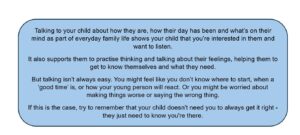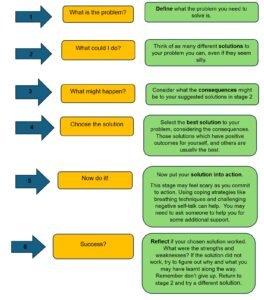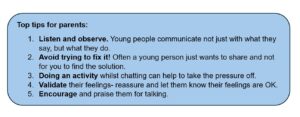Worry Box

A worry box is an approach to addressing excessive worry and anxiety in children, it aims to take the worry and anxiety away from the child and place it onto a tangible item such as a box.
The first step can be decorating the box if the young person wants to. This can help them to feel some sort of ownership over the activity as well as empowerment in dictating the physical appearance of the worry box. Some children feel more comfortable talking and expressing difficult or uncomfortable feelings while either moving their body or by being distracted by something else. Therefore, this initial phase of the project serves as a beneficial time to discuss, explore, and process concepts and ideas relating to the project.
Next, the ‘worries’ that the young person is experiencing are written down onto strips of paper which are then folded and added to the worry box.
Every day (or however often is deemed appropriate), an adult and child can check in with each other using the worry box. For example, begin by having the young person take out one strip of paper at a time. The strips of paper with worries written on them serve as excellent visuals to spur conversation and processing.
Through discussion, the young person will indicate whether that worry is still bothering them. If that is the case, the child can fold the paper back up and place it back into the box. If they feel as though this is not something that is a worry anymore, the young person and adult can discuss a ritual for disposing of the paper. For example, maybe they would like to rip it into several pieces and throw it away. This is also an excellent place in the project for the young person to exert some independence and control in deciding the mode of disposal.
Support for Parent/carer
How can you support your child with their mental health?
Developing day-to-day positive mental health habits are an effective way to look after your own mental well-being. Below are some suggestions to help your child develop good habits.
Try and talk openly about mental health.
Just as you might encourage them to eat fruit and veg to keep their bodies healthy, try and talk more openly about how for example, staying connected with others or being physically active can help to take care of our mental health.
Model good habits.
Young people and children often learn from what they see around them. Looking after your own mental health helps to show them what good habits look like.
Phone usage – both theirs and yours
Using phones and laptops can impact on our sleep, which is important to our mental health. Being mindful of your child’s phone use, especially late at night is important. Phones can also become a barrier to connecting more with others, where we are distracted and less likely to listen.
Notice any changes in your child’s behaviour.
Young people tell us how they’re feeling in many ways, not always verbally. Learning what is normal for your child makes it easier to notice when things change, and if this might be a sign that they’re struggling.
Let your child know that you’re concerned
Explain why you feel that way, e.g. if you’ve noticed they haven’t been interested in activities they usually enjoy.
The POWER of talking and listening

The video below is from a teenager’s perspective about the importance of listening.





